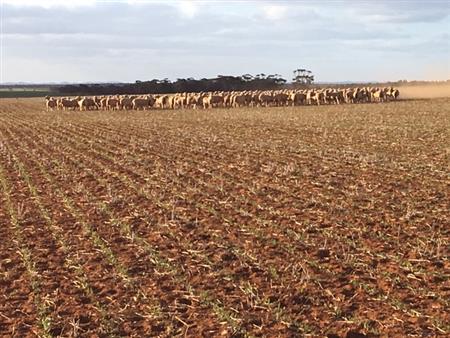- Grazing management is essential to ration feed and maintain ground cover
- Do a feed budget
- Livestock management is about monitoring livestock condition, soil cover and pasture growth. Do not put stock in a paddock and forget about them
- Check chemical grazing withholding periods, before grazing
- Rotationally graze paddocks using large mobs for short periods rather than small mobs grazing for longer periods. This reduces wastage, prevents camping and ensures more even grazing over the paddock

The continued dry conditions and frosts throughout July in many districts has meant that crop and pasture growth has been slow. Without adequate soil moisture crops and pastures will quickly become stressed as temperatures begin to increase. Without substantial rain in the next few weeks there will be limited pasture growth, even in spring.
Cereal crops with poor/patchy emergence have low grain yield potential and some crops have already been grazed in late June/early July with the hope that rain in July would allow them to recover. However with minimal rain in many areas recovery has been slow.
The question is do you continue to graze these crops to maintain livestock or leave them to be harvested or grazed later?
Grazing Green Crops
This is an option, however there are a number of things to consider.
It is important to have a plan for:
- 1.Good rainfall in early August
- Re-sow areas with poor crop establishment to increase soil cover and provide extra livestock feed.
- Where good crop establishment has been achieved, crops could be harvested.
- 2.Below average late July/early August rainfall
- Rotationally graze crops, using high stock density for short periods. With large paddocks consider sub dividing with either electric fencing or cyclone to enable high stock density.
- Check the grazing withholding periods (GWP) of chemicals applied to the crop, before grazing. GWP is the minimum time between chemical application and harvest for stockfeed or grazing to ensure the maximum reside limit (MRL) and/or export grazing interval (EGI) are not exceeded. This is a legal requirement.
- Estimate the amount of dry matter available from the crop (kg dry matter/ha) and determine how long it can be grazed for. Ensure ground cover remains.
- When grazing cereals continually supplement stock with a source of calcium, salt and magnesium and vaccinate for pulpy kidney prior to putting the stock out on the crop.
- Grazing green crops will leave paddocks relatively bare and exposed for long periods to erosion risk.
Grazing mature crops
In most cases it will be better to leave these crops and graze them as mature crops. This will increase the period that the soil is protected over summer, however with limited pasture feed it may be necessary to graze some crops green and leave the more erosion prone areas to either be harvested or grazed after the crops have matured.
For more information refer to: Grazing cropped land (2016) booklet
By Michael Wurst, PIRSA





